Sedimentary Characteristics of the Neogene in the Eastern Liaodong Area, Bohai Sea, China
Abstract
:1. Introduction
2. Geological Setting
3. Materials and Methods
3.1. Materials
3.2. Methods
4. Results
4.1. Sequence Stratigraphic Framework
4.1.1. Identification of Sequence Boundaries
4.1.2. Sequence Stratigraphic Framework Characteristics
4.2. Characteristics of Paleoclimate
4.3. Types and Distribution Characteristics of Sedimentary Facies
4.3.1. Types of Sedimentary Facies
- Braided River Delta
- 2.
- Meandering River Delta
- 3.
- Meandering River
4.3.2. Distribution Characteristics of Sedimentary Facies
5. Discussion
5.1. Controlling Factors of Sedimentation
5.1.1. Vertical Evolution of Sediments Controlled by Periodic Rise and Fall of Lake Level under the Influence of Tectonic Movement and Paleoclimate
5.1.2. Transverse Distribution of Sediments Controlled by Paleogeomorphic Background under the Influence of Strike-Slip Faults
5.2. Depositional Model
6. Conclusions
- The Neogene strata in the eastern Liaodong area can be divided into five third-order sequences. Only the SQ-Ngxl at the bottom lacks lacustrine TST, while all the other sequences consist of LST, lacustrine TST and HST.
- The Neogene sediments in the eastern Liaodong area are under the delta-fluvial sedimentary system. In this system, three sedimentary facies, which are the braided river delta, meandering river delta and meandering river, and eight sedimentary microfacies, can be identified. The sedimentary evolution can be divided into four stages: braided river delta, meandering river delta with a low sand-stratum ratio, meandering river delta with a high sand-stratum ratio, and meandering river delta.
- The sedimentary fillings evolution is controlled by tectonic movement, paleoclimate and paleogeomorphology. The vertical evolution of the sediments is controlled by a periodic rise and fall of the lake’s level under the influence of tectonic movement and paleoclimate, while the transverse distribution of the sediments is controlled by a paleogeomorphic background under the influence of strike-slip faults. Therefore, a depositional model, in which the slopes control facies, the valleys control rivers and the fault slopes control sand bodies, can be established.
Author Contributions
Funding
Institutional Review Board Statement
Informed Consent Statement
Data Availability Statement
Conflicts of Interest
References
- Baum, G.; Vail, P. Sequence stratigraphic concepts applied to Paleogene outcrops, Gulf and Atlantic Basins. In Sea Level Changes: An Integrated Approach; SEPM Special Publication: Tulsa, Oklahoma, 1988; Volume 42, pp. 309–327. [Google Scholar]
- Vakarcs, G.; Vail, P.R.; Tari, G. Third-order Middle Miocene-Early Pliocene depositional sequences in the prograding delta complex of the Pannonian Basin. Tectonophysics 1994, 240, 81–106. [Google Scholar] [CrossRef]
- Zhang, Z.L.; Zhu, X.M.; Zhang, R.F. To establish a sequence stratigraphy in lacustrine rift basin: A 3D seismiccase study from paleogene Baxian Sag in Bohai Bay Basin, China. Mar. Pet. Geol. 2020, 120, 104505. [Google Scholar] [CrossRef]
- Xia, S.Q.; Lin, C.S.; Wu, W. Sequence architecture, depositional evolution and responses to tectonic subsidence and lacustrine fluctuation in lacustrine rift basin: A case study from Cenozoic Liaodong Bay, Bohai Bay Basin. J. Pet. Sci. Eng. 2022, 208, 109494. [Google Scholar] [CrossRef]
- Xu, X.; Liu, L.Y. Sequence stratigraphy, sedimentary characteristics of barrier coastalsedimentary system of the Benxi Formation (Gaoqiao area, Ordosbasin) and favorable reservoir distribution. Energy Rep. 2021, 7, 5316–5329. [Google Scholar] [CrossRef]
- Wang, S.Q.; Lin, C.S.; Li, H. Sequence stratigraphy and sedimentary characteristics of the shelf-edge delta and slope fan systems in the Late Oligocene, Baiyun Sag, Pearl River Mouth Basin, China. Mar. Pet. Geol. 2022, 136, 105441. [Google Scholar] [CrossRef]
- Hassan, M.H.; Johnson, D.H.; Allison, P.A. Sedimentology and stratigraphic development of the upper NyalauFormation (Early Miocene), Sarawak, Malaysia: A mixed wave-and tide-influenced coastal system. J. Asian Earth Sci. 2013, 76, 301–311. [Google Scholar] [CrossRef]
- Ge, J.W.; Zhao, X.M.; Tan, M.X. Sequence stratigraphy and depositional evolution of the north-eastern shelf (33.9–10.5 Ma) of the Pearl River Mouth basin, South China Sea. Mar. Pet. Geol. 2022, 141, 105697. [Google Scholar] [CrossRef]
- Shang, W.L.; Xu, S.H.; Mao, Z.Q. High-resolution sequence stratigraphy in continental lacustrine basin: A case of Eocene Shahejie formation in the Dongying Depression, Bohai Bay Basin. Mar. Pet. Geol. 2022, 136, 105438. [Google Scholar] [CrossRef]
- Xu, C.G.; Huan, L.; Song, Z.Q. Sequence stratigraphy of the lacustrine rift basin in the Paleogene system of the Bohai Sea area: Architecture mode, deposition filling pattern, and response to tectonic rifting processes. Interpretation 2020, 8, SF57–SF79. [Google Scholar] [CrossRef]
- Liu, L.; Chen, H.D.; Wen, H.G. Facies architecture and sediment infilling processes in intrabasinal slopebelts of lacustrine rift basins, Zhanhua Depression, Bohai Bay Basin. Mar. Pet. Geol. 2020, 112, 104089. [Google Scholar] [CrossRef]
- Li, X.P.; Wang, H.; Gan, H.J. Stratigraphic charactertistic and tectonic control on the paleogene sedimentary evolution of the Baxian Half-graben, Bohai Bay Basin, east China. J. Pet. Sci. Eng. 2019, 181, 106145. [Google Scholar] [CrossRef]
- Li, Q.; Zhang, Z.L.; Zhang, J. Characteristics of sedimentary differential response for multi-episode rifting cycles in lacustrine rift basin: A case study of the Palaeogene Baxian sag in the Bohai Bay Basin. Mar. Pet. Geol. 2022, 136, 105426. [Google Scholar] [CrossRef]
- Sun, L.D.; Fang, C.L.; Li, F. Petroleum exploration and development practices of sedimentary basins in China and research progress of sedimentology. Pet. Explor. Dev. 2010, 37, 385–396. [Google Scholar]
- Zeng, H.L.; Zhao, X.Z.; Zhu, X.M. Seismic sedimentology of sub-clinoformal shallow-water meandering river delta: A case from the Suning area of Raoyang sag in Jizhong depression, Bohai Bay Basin, NE China. Pet. Explor. Dev. 2015, 42, 621–632. [Google Scholar] [CrossRef]
- Li, Y.; Fan, A.P.; Yang, R.C. Sedimentary facies control on sandstone reservoir properties: A case study from the permian Shanxi Formation in the southern Ordos basin, central China. Mar. Pet. Geol. 2021, 129, 105083. [Google Scholar] [CrossRef]
- Aigbadon, G.O.; Christopher, S.D.; Akudo, E.O. Sedimentary facies and textural characteristics of Cretaceoussandstones in the southern Bida Basin, Nigeria: Implication forreservoir potential and depositional environment. Energy Geosci. 2022, 3, 323–341. [Google Scholar] [CrossRef]
- Zeng, Z.W.; Zhu, H.T.; Zeng, H.L. Seismic sedimentology analysis of fluvial-deltaic systems in a complex strike-slip fault zone, Bohai Bay Basin, China: Implications for reservoir prediction. J. Pet. Sci. Eng. 2022, 208, 109290. [Google Scholar] [CrossRef]
- Deng, Y.H.; Li, J.P. Formation Mechanism of Shallow Oil and Gas Reservoirs: A Case Study of Bohai Oil Area; Petroleum Industry Press: Beijing, China, 2008; pp. 23–28. [Google Scholar]
- Zhu, W.L.; Mi, L.J.; Gong, Z.S. Hydrocarbon Accumulation and Exploration in Bohai Sea Area; Science Press: Beijing, China, 2009; pp. 41–44. [Google Scholar]
- Yang, H.F.; Xu, C.G.; Gong, Z.S. Quantitative evaluation of hydrocarbon accumulation pattern and the controlling factors in the Neogene of Huanghekou Sag, Bohai Bay Basin. Oil Gas Geol. 2020, 41, 259–269. [Google Scholar]
- Teng, C.Y.; Zou, H.Y.; Hao, F. Control of differential tectonic evolution on petroleum occurrence in Bohai Bay Basin. Sci. China Earth Sci. 2014, 57, 1117–1128. [Google Scholar] [CrossRef]
- Xu, C.G.; Jing, P.H.; Wu, F.D. Discovery and sedimentary characteristics of the Neogene delta in Bozhong Depression and its significance for oil and gas exploration. Acta Sedimentol. Sin. 2002, 20, 588–594. [Google Scholar]
- Xu, Z.H.; Wu, S.H.; Liu, Z. Sandbody architecture of the bar finger within shoal water delta front: Insights from the Lower Member of Minghuazhen Formation, Neogene, Bohai BZ25 Oilfield, Bohai Bay Basin, East China. Pet. Explor. Dev. 2019, 46, 322–333. [Google Scholar] [CrossRef]
- Zhu, W.L.; Li, J.P.; Zhou, X.H. Neogene Shallow Water Deltaic System and Large Hydrocarbon Accumulations in Bohai Bay, China. Acta Sedimentol. Sin. 2008, 44, 575–582. [Google Scholar]
- Wang, D.Y.; Yu, H.Z.; Yu, H.B. An analysis and refined depiction of lithologic trap development under the framework of Neogene sequence stratigraphy in Bohai water: A case of Lower Member of Minghuazhen Formation in Shijiutuo rise. China Offshore Oil Gas 2012, 24, 23–28. [Google Scholar]
- Tan, M.X.; Zhu, X.M.; Zhang, Z.L. Fluvial sequence pattern and its response of geomorphy in depression phase of rift basin: A case study of the Lower Member of Neogene Minghuazhen Formation in Shaleitian Uplift area, Bohai Bay Basin. J. Palaeogeogr. 2020, 22, 428–439. [Google Scholar]
- Zhao, H.Q.; Zhang, J.M.; Li, S.B. Sedimentary Characteristics and Evolution Models of Lower Part of Minghuazhen Formation in Neogene System in Oilfield A, Bohai Bay Basin. J. Jilin Univ. Earth Sci. Ed. 2017, 47, 1021–1029, 1046. [Google Scholar]
- Xu, C.G.; Yang, H.F.; Wang, D.Y. Formation conditions of Neogene large-scale high-abundance lithologic reservoir in the Laibei low uplift, Bohai Sea, East China. Pet. Explor. Dev. 2021, 48, 12–25. [Google Scholar] [CrossRef]
- Zhao, G.X.; Guan, D.Y.; Liu, P.B. Sedimentary Characteristics and Sand Body Evolution of Shallow Braided River Delta of Guantao Formation in Miaoxi’nan Uplift, Bohai Sea Area. Acta Sedimentol. Sin. 2018, 36, 807–817. [Google Scholar]
- Yang, G.L. Analysis on Oil/Gas Reservoir-forming Conditions in Eastern Liaodong Region, Bohai Sea. Spec. Oil Gas Reserv. 2014, 21, 76–79. [Google Scholar]
- Xiong, W.; Zhang, M.H.; Xu, H.Q. Oil and Gas Accumulation and Exploration Potential in the Shengshun Oilfield, the Bohai sea. Mar. Geol. Front. 2017, 33, 42–47. [Google Scholar]
- Xian, B.Z.; Wang, Z.; Ma, L.C. Paleao-Drainage System and Integrated Paleo-Geomorphology Restoration in Depositional and Erosional Areas: Guantao Formation in East Liaodong Area, Bohai Bay Basin. China. Earth Sci. 2017, 42, 1922–1935. [Google Scholar]
- Zhang, Y.; Yao, Y.J.; Li, X.J. Tectonic evolution and resource-environmental effect of China Seas and adjacent areas under the multisphere geodynamic system of the East Asia ocean-continent convergent belt since Mesozoic. Geol. China 2020, 47, 1271–1309. [Google Scholar]
- Zhang, X.Q.; Wu, Z.P.; Zhou, X.H. Cenozoic Tectonic Characteristics and Evolution of the Southern Bohai Sea. Geotecton. Metallog. 2017, 41, 50–60. [Google Scholar]
- Zhang, J.T.; Wu, K.; Wang, B.J. Apatite fission track evidence of Cenozoic tectonic evolution in the northern section of Liaoxi uplift, Bohai Sea. Acta Pet. Sin. 2018, 39, 1262–1271. [Google Scholar]
- Hou, G.T.; Qian, X.L. The Tectonic Evolution of Bohai Basin in Mesozoic and Cenozoic Time. Acta Sci. Nat. Univ. Pekin. 2001, 37, 845–851. [Google Scholar]
- Zhou, B.; Deng, Z.H.; Xu, J. Characteristics of neotectonism and their relationship with late hvdrocarbon accumulation in the Bohai sea. Prog. Geophys. 2009, 24, 2135–2144. [Google Scholar]
- Chang, Y.Y.; Lin, C.S.; Zhou, X.H. Depositional sequences and prediction of favorable reservoir sand of Shahejie Foramtion of Liaoxi Depression. Earth Sci. J. China Univ. Geosci. 2014, 39, 1371–1380. [Google Scholar]
- Feng, Y.L.; Zhou, H.M.; Ren, J.Y. The Paleogene stratigraphic sequences and its responses to tectonic activities in the eastern part of Bohai Bay Basin. Sci. China Earth Sci. 2010, 40, 1356–1376. [Google Scholar]
- Hsiao, L.Y.; Graham, S.A.; Tilander, N. Stratigraphy and sedimentation in a rift basin modified by synchronous strike-slip deformation: southern Xialiaohe basin, Bohai, offshore China. Basin Res. 2010, 22, 61–78. [Google Scholar] [CrossRef]
- Yu, Z.H. The Control of Sequence Stratigraphy and Tectonic on Sediment Filling on Neogene in Huanghekou Depression; China University of Geosciences: Beijing, China, 2009. [Google Scholar]
- Ju, Y.T. Study on Sequence Stratigraphy and Stuble Reservoir in the Huangjekou Sag, Bohai Bay Basin; China University of Geosciences: Beijing, China, 2012. [Google Scholar]
- Wang, Y.B.; Huang, L.; Liu, T.H. The main characteristics and tectonic types of neotectonic movement in Bohai Sea. China Offshore Oil Gas 2012, 24, 6–10. [Google Scholar]
- Li, C.Z.; Xu, G.S.; Xu, F.H. A model for faults to link the Neogene reservoirs to the Paleogene organic-rich sediments in low-relief regions of the south Bohai Sea, China. J. Pet. Sci. Eng. 2021, 200, 108360. [Google Scholar] [CrossRef]
- Jiang, Z.X. Advances in sequence stratigraphy: A summary from International Workshop on Sequence Stratigraphy. Earth Sci. Front. 2012, 19, 1–9. [Google Scholar]
- Jiang, Y.M.; Shao, L.Y.; Li, S. Deposition System and Stratigraphy of Pinghu Formation in Pinghu Tectonic Belt, Xihu Sag. Geoscience 2020, 34, 141–153. [Google Scholar]
- Xu, N.N.; Qiu, L.W.; Liu, K.Y. Sedimentary Facies of the Upper Part of the Fourth Menmber of the Shahejie Formation in the Bonan-Luojia Area of the Zhanhua Sag. J. Stratigr. 2015, 39, 223–231. [Google Scholar]
- Yuan, Q.; Barbolini, N.; Ashworth, L. Palaeoenvironmental changes in Eocene Tibetan lake systems traced by geochemistry, sedimentology and palynofacies. J. Asi. Earth Sci. 2021, 214, 104778. [Google Scholar] [CrossRef]
- He, J.X.; Zhang, W.; Yan, W. Episodic Tectonic Evolution, Basin Types and Hydrocarbon Accumlation in Chinese Marginal Basins. Mar. Geol. Quat. Geol. 2014, 34, 121–133. [Google Scholar] [CrossRef]
- Pan, W.J.; Du, X.F.; Wang, Q.B. Neocene Palaeontological Characteristics and Its Paleoenvironment Significance During the Withering Period of the Lacustring Basin in the Southeastern Bohia Sea, North China. Acta Micropalaeontol. Sin. 2018, 35, 238–249. [Google Scholar]
- Lai, W.C.; Cheng, J.C.; Zhou, X.H. Sedimentary sequence division and sand body characteristics of peneplain during lacustrine atrophy: A case study of the Lower Member of The Ming Neogene in the Yellow River Estuary. China Offshore Oil Gas 2009, 21, 157–161. [Google Scholar]
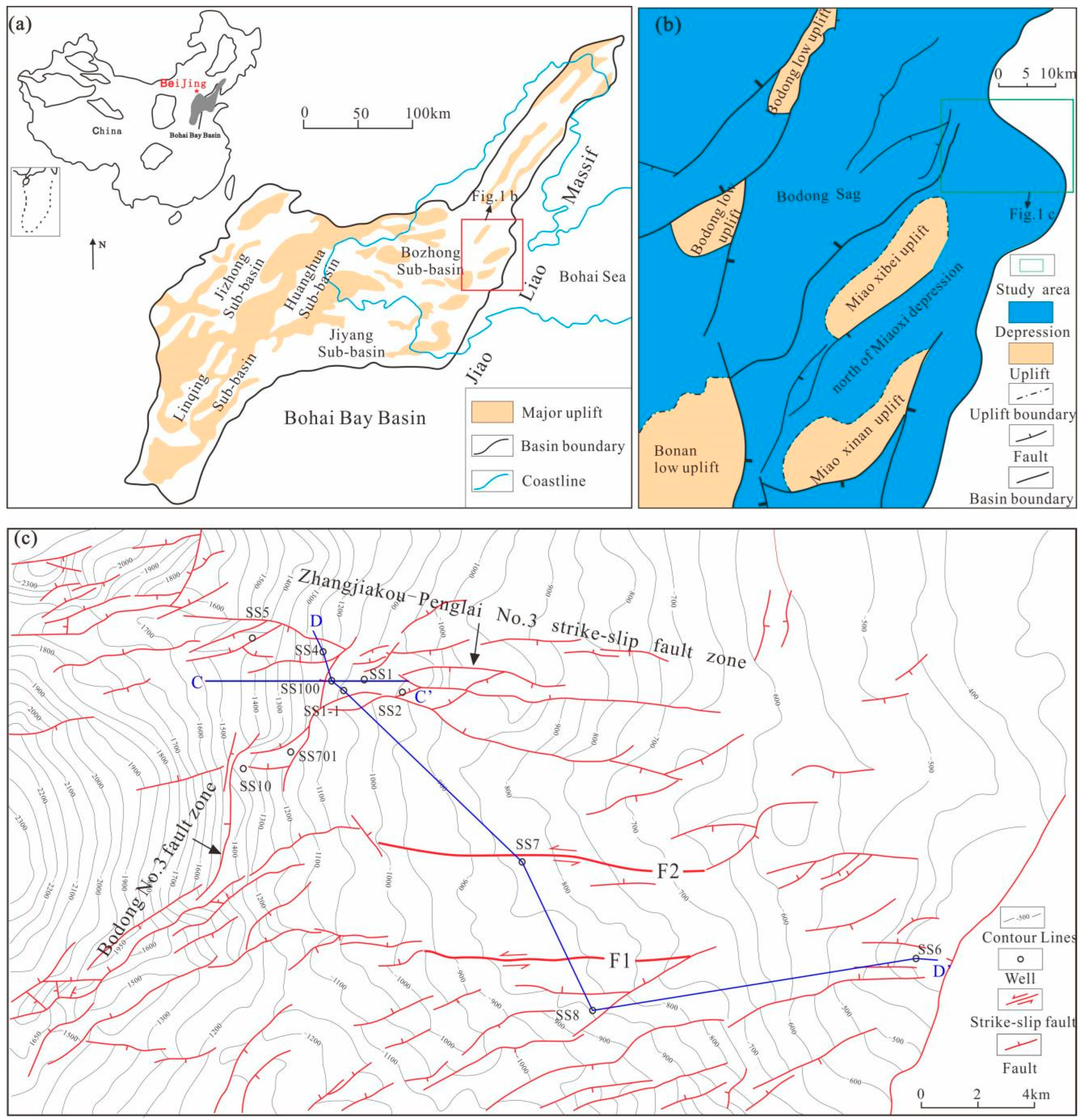
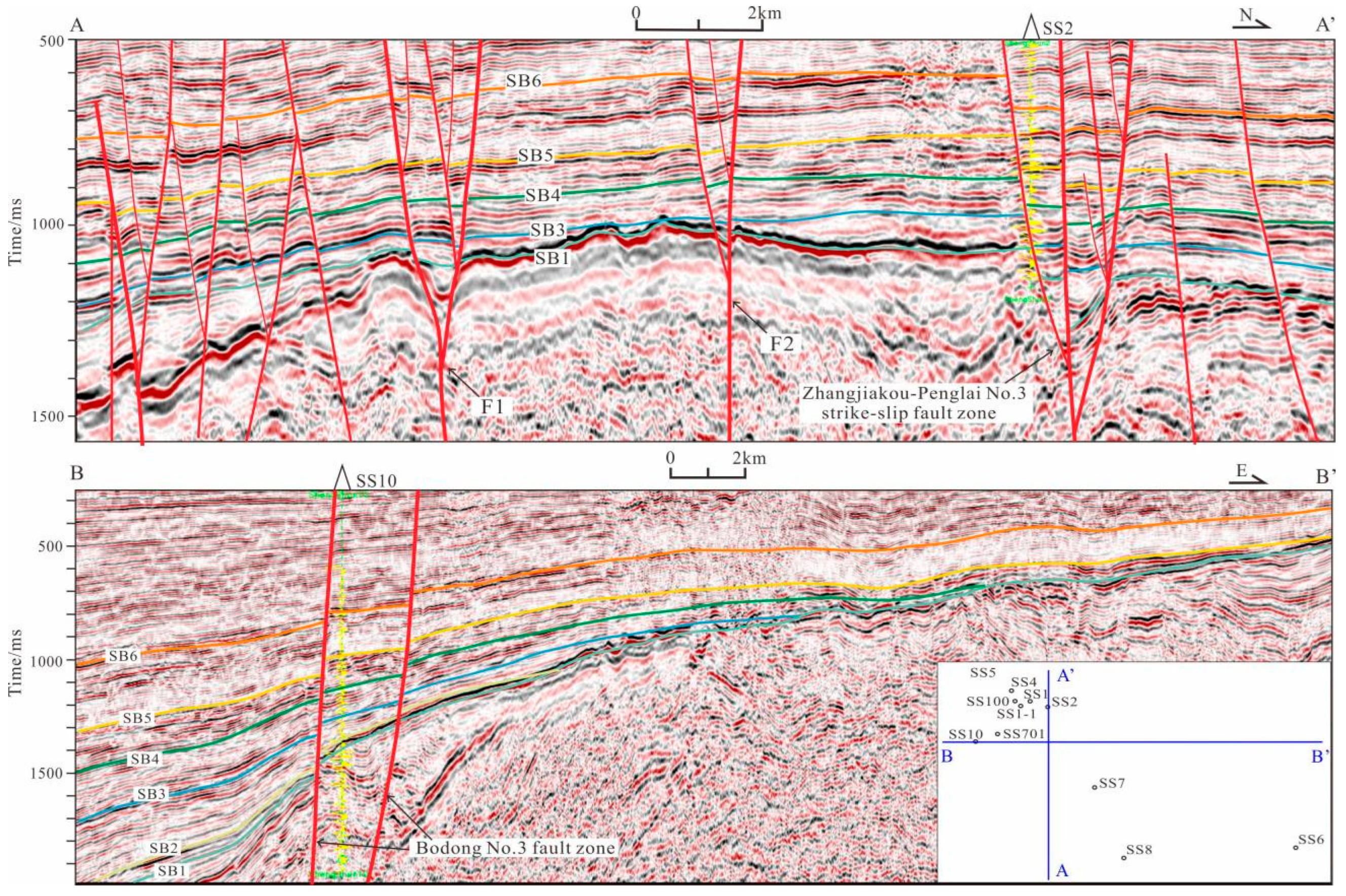
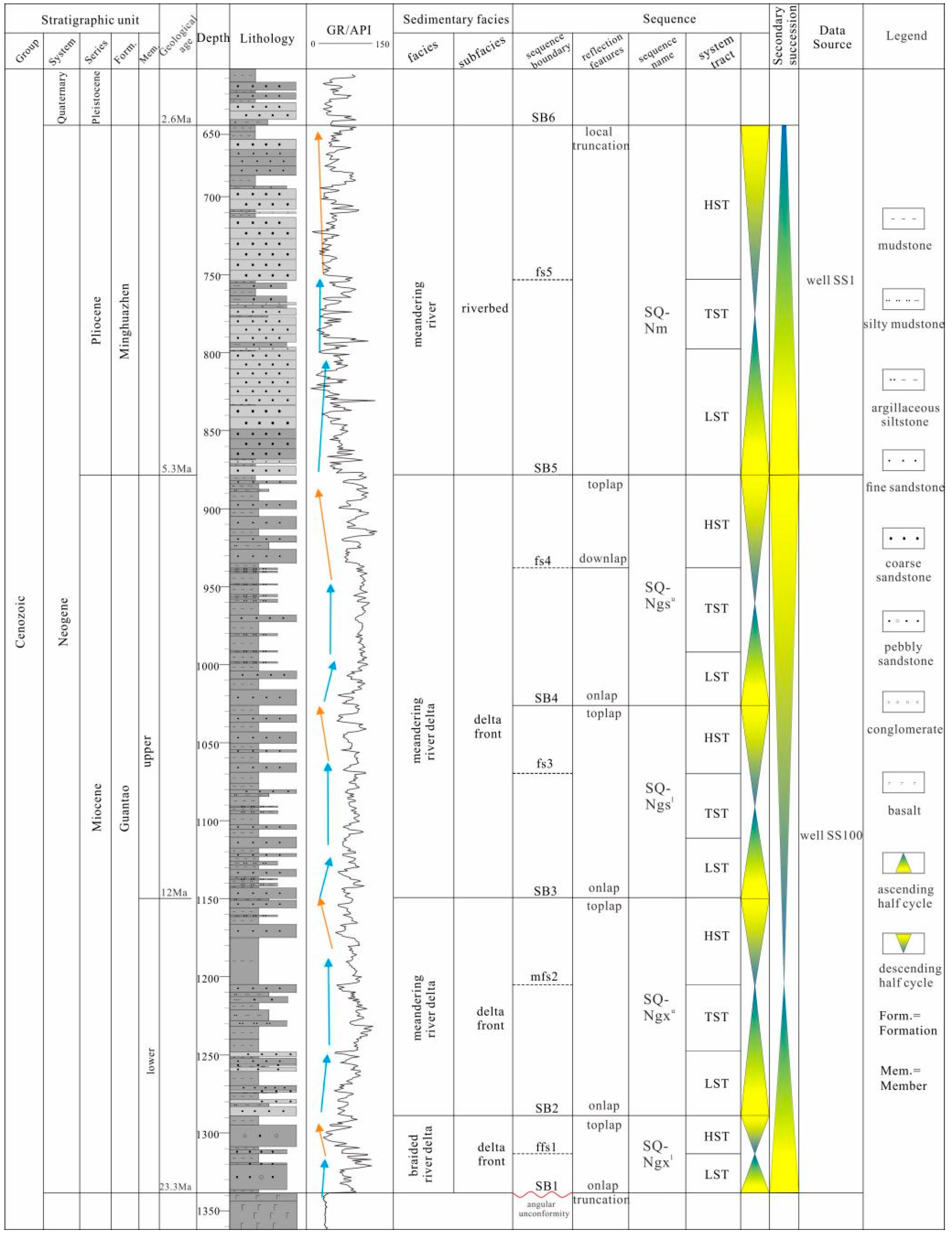
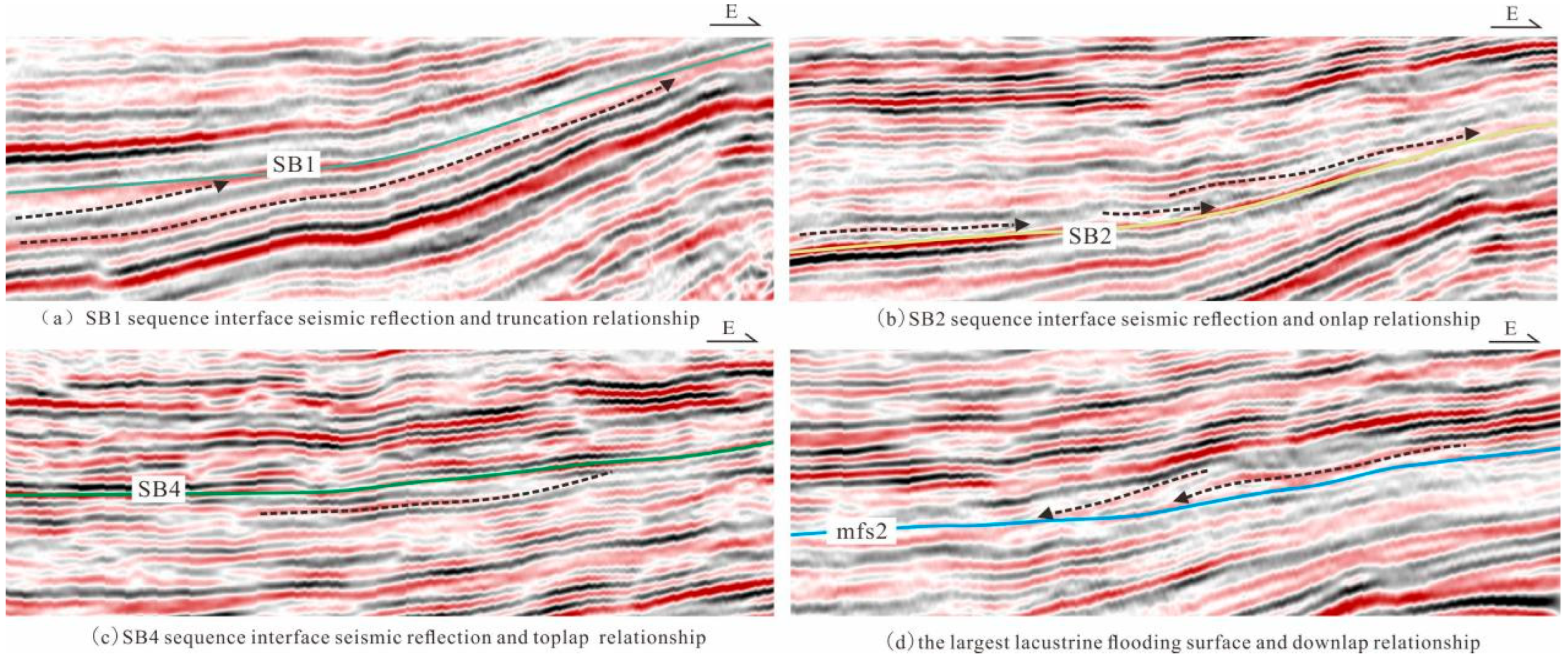
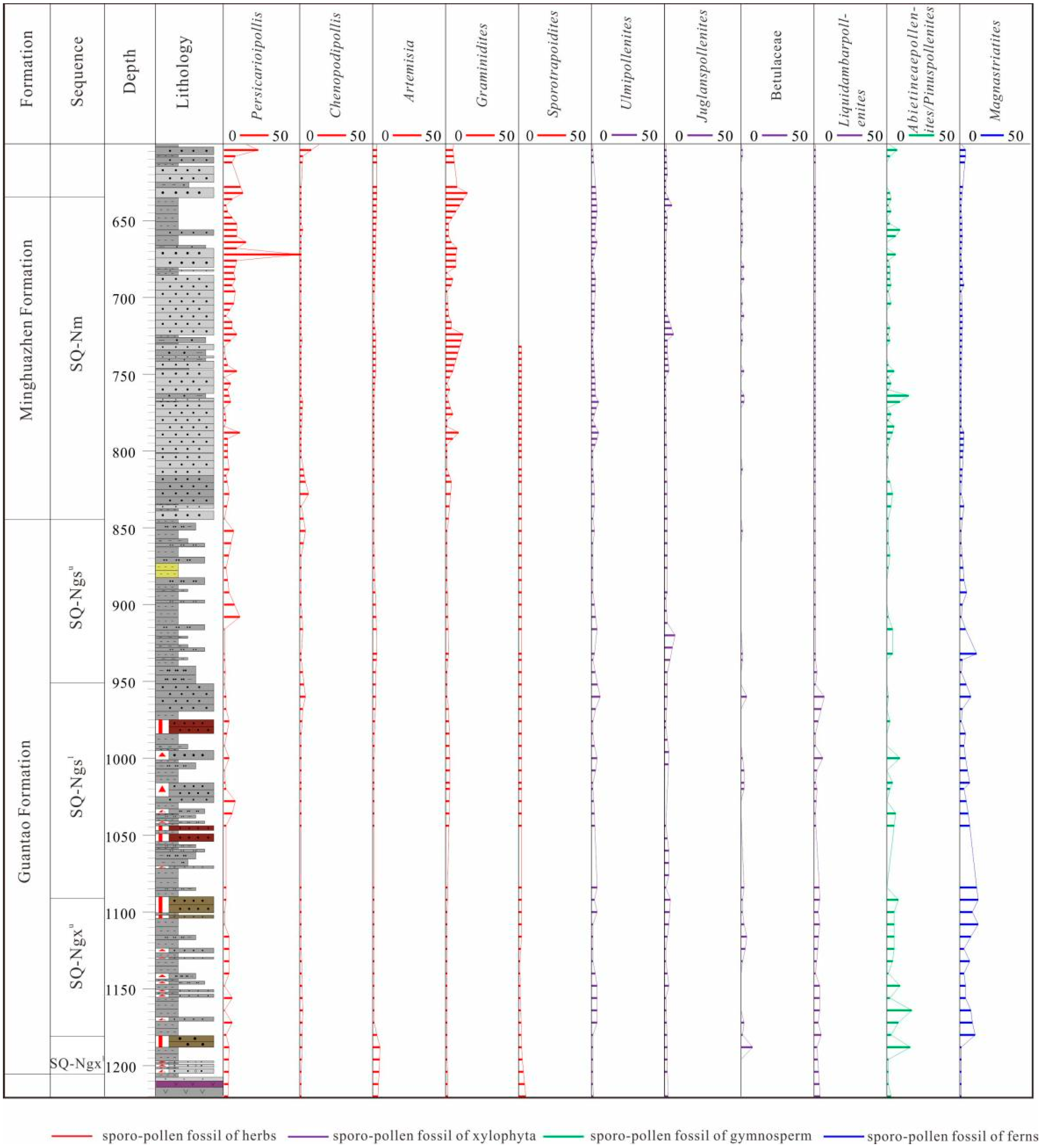
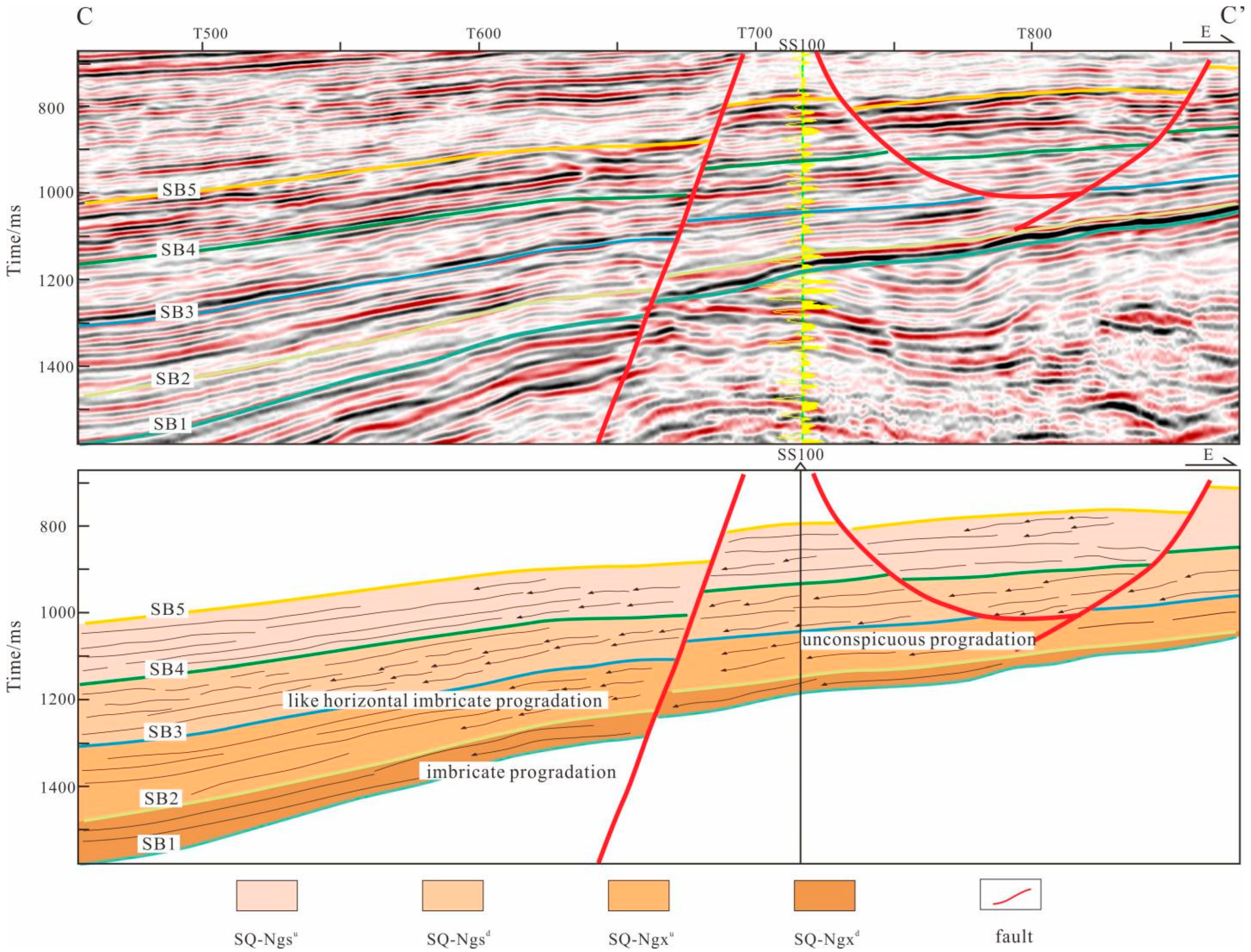
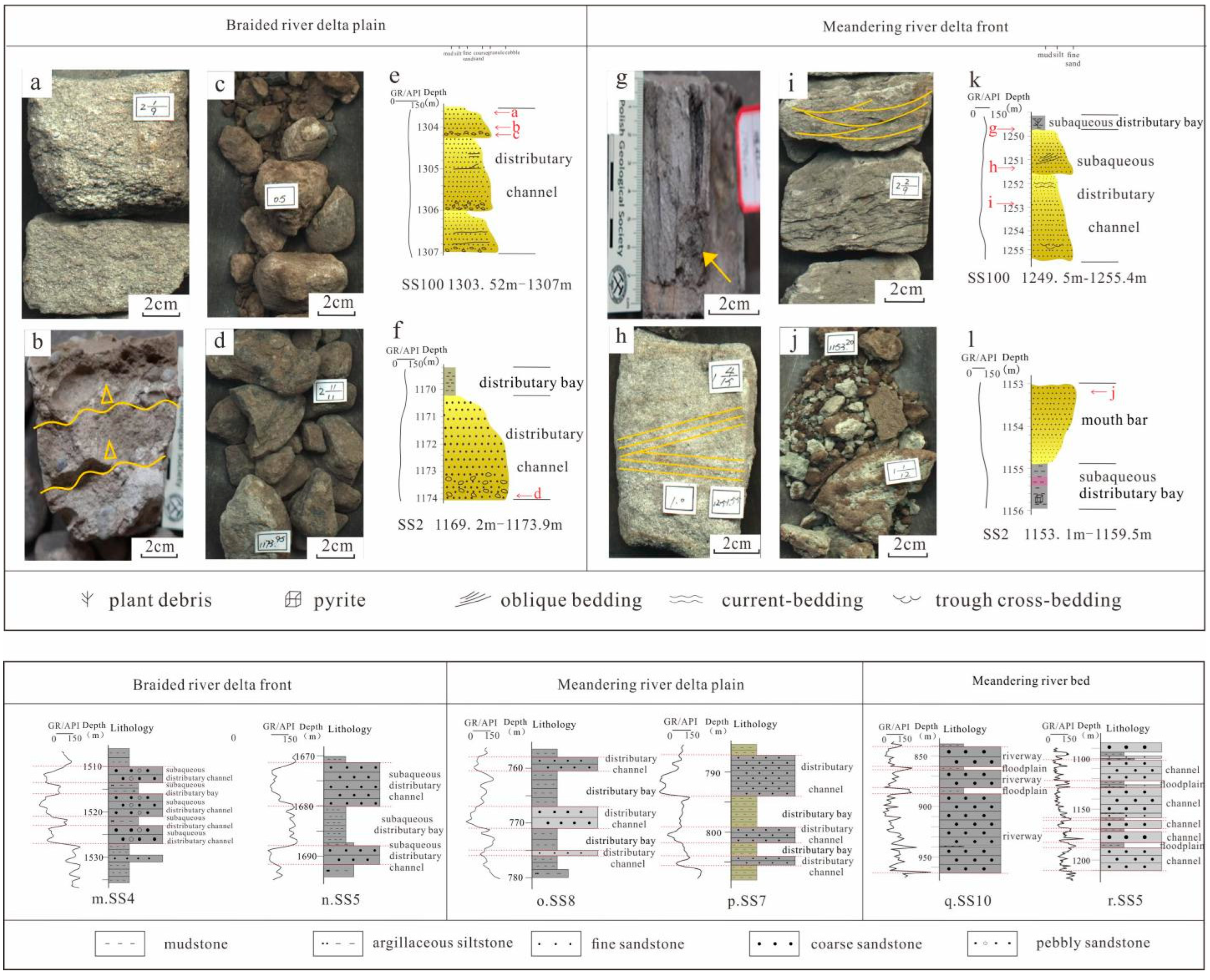
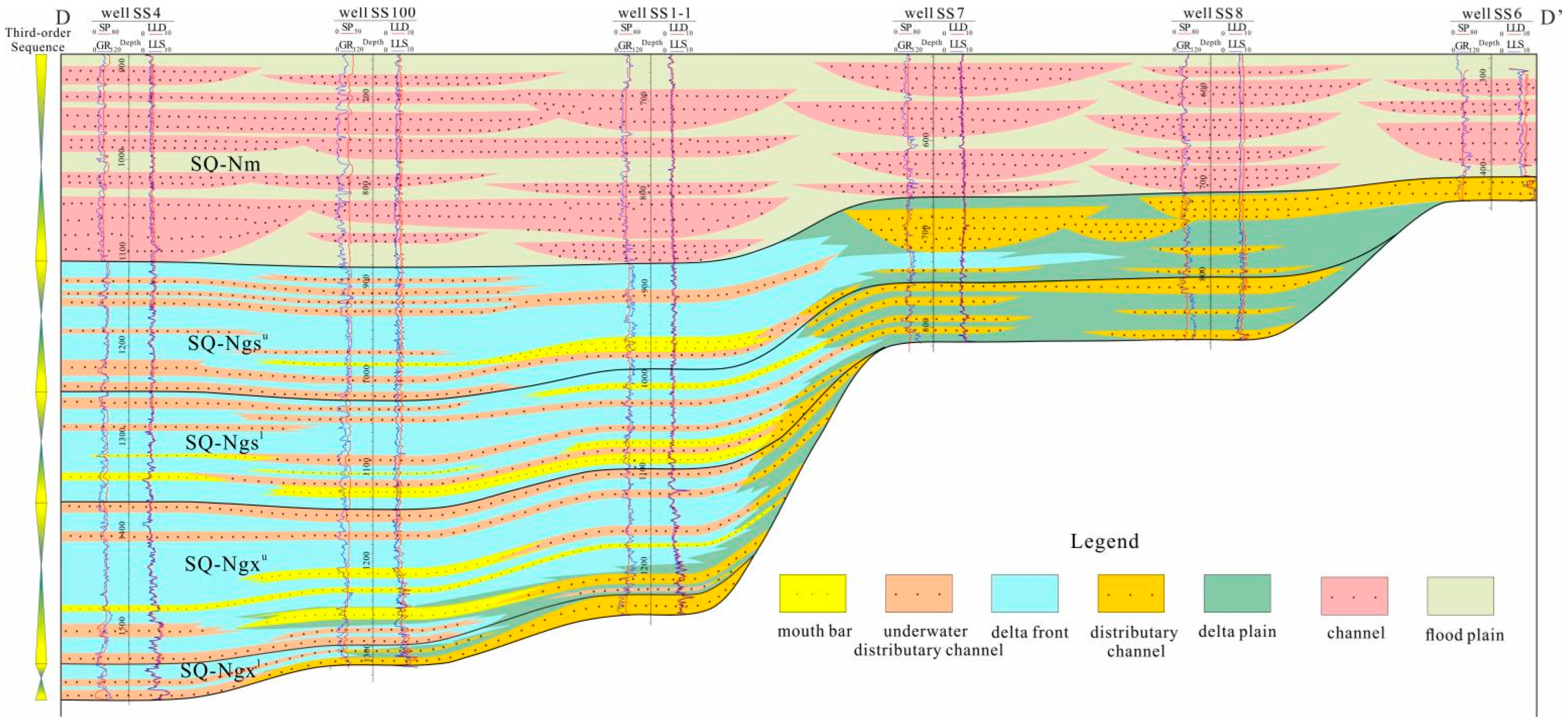
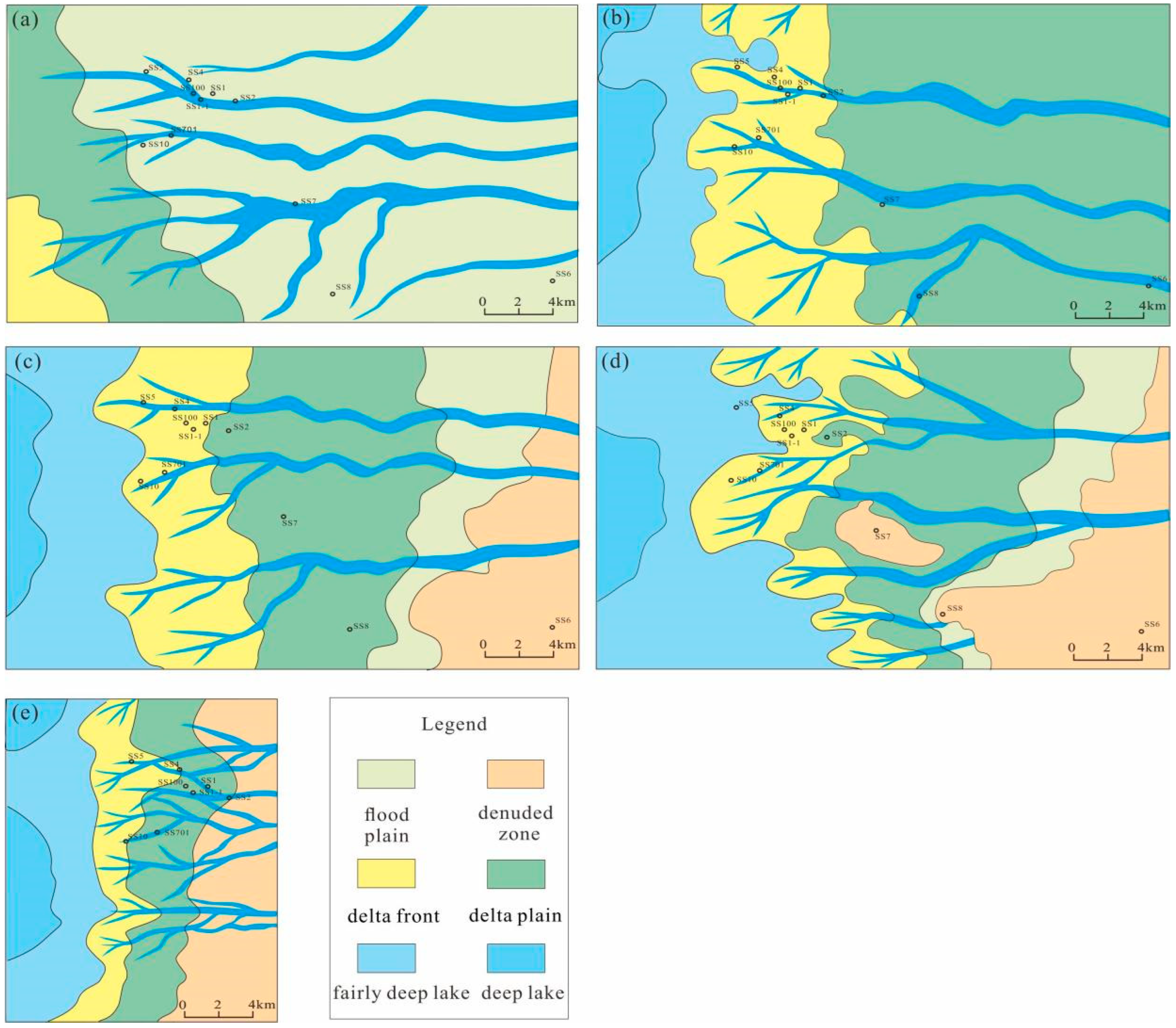

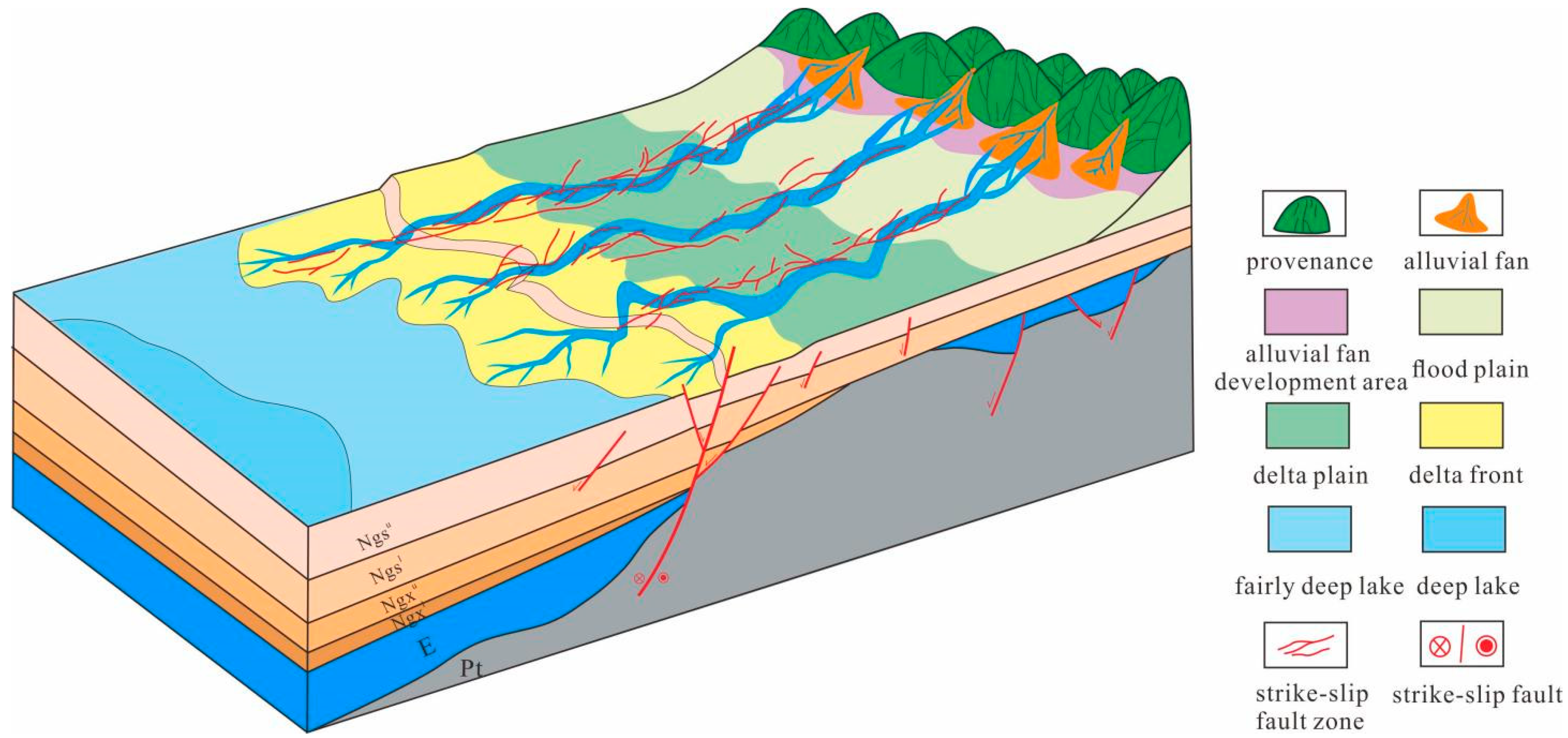
Publisher’s Note: MDPI stays neutral with regard to jurisdictional claims in published maps and institutional affiliations. |
© 2022 by the authors. Licensee MDPI, Basel, Switzerland. This article is an open access article distributed under the terms and conditions of the Creative Commons Attribution (CC BY) license (https://creativecommons.org/licenses/by/4.0/).
Share and Cite
Hao, R.; Wang, Y.; Wang, J.; Wu, Z.; Jing, A.; Liu, X.; Xu, H.; Wu, Q. Sedimentary Characteristics of the Neogene in the Eastern Liaodong Area, Bohai Sea, China. Energies 2022, 15, 4704. https://doi.org/10.3390/en15134704
Hao R, Wang Y, Wang J, Wu Z, Jing A, Liu X, Xu H, Wu Q. Sedimentary Characteristics of the Neogene in the Eastern Liaodong Area, Bohai Sea, China. Energies. 2022; 15(13):4704. https://doi.org/10.3390/en15134704
Chicago/Turabian StyleHao, Ranran, Yongshi Wang, Jing Wang, Zhiping Wu, Anyu Jing, Xiaolin Liu, Haoqing Xu, and Qunhu Wu. 2022. "Sedimentary Characteristics of the Neogene in the Eastern Liaodong Area, Bohai Sea, China" Energies 15, no. 13: 4704. https://doi.org/10.3390/en15134704
APA StyleHao, R., Wang, Y., Wang, J., Wu, Z., Jing, A., Liu, X., Xu, H., & Wu, Q. (2022). Sedimentary Characteristics of the Neogene in the Eastern Liaodong Area, Bohai Sea, China. Energies, 15(13), 4704. https://doi.org/10.3390/en15134704




